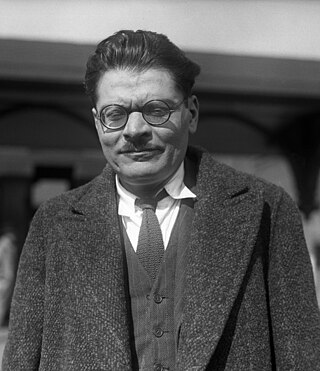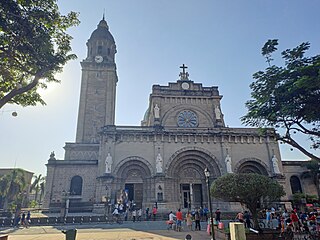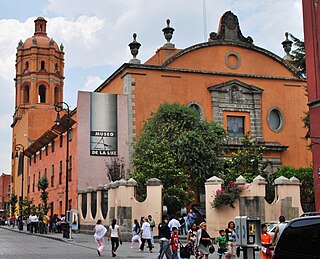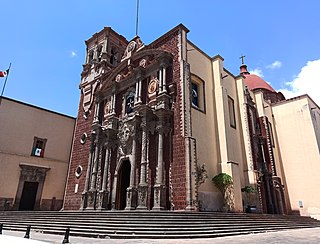
The Preparatoria De Jalisco is a school upper secondary education located in the historic city centre of Guadalajara in Mexico.

The Preparatoria De Jalisco is a school upper secondary education located in the historic city centre of Guadalajara in Mexico.
In 1720 Pope Clement XI confirmed the creation of an oratorium dictated to Saint Phillip Neri in the city of Guadalajara, Jalisco, which at the time was part of New Spain and capital of the Nueva Galicia Kingdom. Informed of the Pope's decision, King Philip V of Spain announced on 13 August 1721 that construction of the new oratorium would begin.[ citation needed ]
In the early 19th century, the institution existed as the Colegio San Felipe Neri. It was used as a hospital and an orphanage. [1]
On September 15, 1914, the Preparatory School of Jalisco was formally established. Since 1925, it has been a part of the University of Guadalajara. [2] Your Majesty Don Fernando VI de Borbón, King of Spain, ordered the Philippians to move to the Plazuela de la Palma or San Fernando, a place where they would erect a chapel dedicated to the Virgin of the Assumption and where they would also found their school in order to comply with the educational role entrusted to them.
The work was finished little by little, first the single-level school with its patios of Plateresque influence, the Mudejar and later the consecration of the temple that occurred in the year 1802.
The main façade of the school is located on what is now Calle de San Felipe (view to the south), and that the second floor was added later during the fourth decade of the 19th century. The high clergy made it available to the order of the Sisters of Charity, who used it as a hospital for the needy in the period from 1850 to 1867.
Later, the president of the republic, Lic. Benito Juárez, ordered that the old cloister be designated to house the homeless high school. Thus, the presidential provisions were fulfilled and it gave shelter to orphan girls.
Years later it remained in the hands of the Society of Jesus, being used as a school for the third time under the name "Instituto del Señor San José". For this reason, the Jesuits adorned the building, taking on its façade the neoclassical French style, concluding the second floor and equipping the Physics, Chemistry and Biology laboratories that are still preserved.
Special mention deserves the library of the campus, designed by the San Felipe oratories, but completed by the Jesuit priests, carved entirely of ebony wood, with two lathes, moldings and neoclassical finials on its old shelves that kept loose books, volumes and exemplary volumes now incunabula. Don Manuel Macario Diéguez ordered the confiscation of the institute and it was vacated by the Jesuits since August 1, 1914.
On September 10 of that same year, he determined in his decree number 29, the creation of the Preparatory School of Jalisco and the formal delivery of the same was made on Tuesday, September 15, 1914. Since 1925, this school has been part of the real estate heritage of the University of Guadalajara and our tradition gathers in the centenary classrooms, the most illustrious figures of the teachers of all time.

Guadalajara is a city in western Mexico and the capital of the state of Jalisco. According to the 2020 census, the city has a population of 1,385,629 people, making it the 7th most populous city in Mexico, while the Guadalajara metropolitan area has a population of 5,268,642 people, making it the third-largest metropolitan area in the country and the twentieth largest metropolitan area in the Americas. Guadalajara has the second-highest population density in Mexico, with over 10,361 people per square kilometer. Within Mexico, Guadalajara is a center of business, arts and culture, technology and tourism; as well as the economic center of the Bajío region. It usually ranks among the 100 most productive and globally competitive cities in the world. It is home to numerous landmarks, including Guadalajara Cathedral, the Teatro Degollado, the Templo Expiatorio, the UNESCO World Heritage site Hospicio Cabañas, and the San Juan de Dios Market—the largest indoor market in Latin America.

José Clemente Orozco was a Mexican caricaturist and painter, who specialized in political murals that established the Mexican Mural Renaissance together with murals by Diego Rivera, David Alfaro Siqueiros, and others. Orozco was the most complex of the Mexican muralists, fond of the theme of human suffering, but less realistic and more fascinated by machines than Rivera. Mostly influenced by Symbolism, he was also a genre painter and lithographer. Between 1922 and 1948, Orozco painted murals in Mexico City, Orizaba, Claremont, California, New York City, Hanover, New Hampshire, Guadalajara, Jalisco, and Jiquilpan, Michoacán. His drawings and paintings are exhibited by the Carrillo Gil Museum in Mexico City, and the Orozco Workshop-Museum in Guadalajara. Orozco was known for being a politically committed artist, and he promoted the political causes of peasants and workers.

The University of Guadalajara is a public research university located in the Mexican city of Guadalajara. The university has several high schools as well as graduate and undergraduate campuses, which are distributed all over the state of Jalisco. It is regarded as the most significant university in the state. Chronologically, based on its foundation, it is the second oldest university in Mexico, the seventeenth oldest in North America and the fourteenth oldest in Latin America.

The Archdiocese of Manila is the archdiocese of the Latin Church of the Catholic Church in Metro Manila, Philippines, encompassing the cities of Manila, Makati, San Juan, Mandaluyong, Pasay, and Taguig. Its cathedral is the Minor Basilica and Metropolitan Cathedral of the Immaculate Conception, also known as the Manila Cathedral, located in Intramuros, which comprises the old city of Manila. The Blessed Virgin Mary, under the title Immaculate Conception, is the principal patroness of the archdiocese.

Tepatitlán de Morelos is a city and municipality founded in 1530, in the central Mexican state of Jalisco. It is located in the area known as Los Altos de Jalisco, about 70 km east of state capital Guadalajara. It is part of the macroregion of the Bajío. Its surrounding municipality of the same name had an area of 1,400 km2. Its most distinctive feature is the Baroque-style parish church in the centre of the city dedicated to Saint Francis of Assisi. Other notable sites include the kiosk that sits on the Plaza de Armas in downtown, the Temple of San Antonio, and the city hall. The latter is one of the most distinctive features in the city, built in neoclassic-baroque style.

Zapopan is a city and municipality located in the Mexican state of Jalisco. Part of the Guadalajara Metropolitan Area, the population of Zapopan city proper makes it the largest city in the state, very close behind the population of Guadalajara proper. It is best known as the home of the Virgin of Zapopan, an image of the Virgin Mary which was made in the 16th century. This image has been credited with a number of miracles and has been recognized by popes and even visited by Pope John Paul II. The municipality is also the home of the Centro Cultural Universitario, which contains one of the most important concert venues in Latin America and is the home of the new stadium for the C.D. Guadalajara.

San Felipe de Neri Church is a historic Catholic church located on the north side of Old Town Plaza in Albuquerque, New Mexico. Built in 1793, it is one of the oldest surviving buildings in the city and the only building in Old Town proven to date to the Spanish colonial period. The church is listed on the New Mexico State Register of Cultural Properties and the National Register of Historic Places and has remained in continuous use for over 200 years.

The Buenos Aires Metropolitan Cathedral, officially called Buenos Aires Metropolitan Cathedral of the Holy Trinity, is the main Catholic church in Buenos Aires, Argentina.

The Basilica of Our Lady of Zapopan and the abbey of the same name are a 17th-century Franciscan sanctuary built in downtown Zapopan, in the state of Jalisco, México.

Ameca is a city and municipality, in Jalisco in central-western Mexico. The municipality covers an area of 839.1 km². The city is bisected by the Ameca River which drains to the Pacific Ocean near Puerto Vallarta. It is located approximately 83 km from the state capital and one of Mexico's largest commercial centers, Guadalajara.

Cuquío is a town and municipality, in Jalisco in central-western Mexico. The municipality covers an area of 248 square miles (643 km2). It limits to the North with the municipality of Yahualica and the State of Zacatecas; to the South, Zapotlanejo and Acatic; to the East, Yahualica and Tepatitlán; and to the West, Ixtlahuacán del Río. Its name derives from the word Cuixui, which in the Aztec language Náhuatl means kite, and is interpreted as "place of kites", or in Tarascan language, "place of frogs or toads". The foundation of the town is awarded to the Purépechas (Tarascans) who repeatedly ventured through these valleys after the Saltpeter War (1480-1510). As a third version about the origins of the municipality name, it is well known that the tribe of coquias settled in La Cofradía, two kilometers from the current town, whose name is conjectured the denomination comes from. Cuquío also depended on the Tonalteca kingdom.

Colegio de San Ildefonso, currently is a museum and cultural center in Mexico City, considered to be the birthplace of the Mexican muralism movement. San Ildefonso began as a prestigious Jesuit boarding school, and after the Reform War it gained educational prestige again as National Preparatory School. This school and the building closed completely in 1978, then reopened as a museum and cultural center in 1992. The museum has permanent and temporary art and archeological exhibitions in addition to the many murals painted on its walls by José Clemente Orozco, Fernando Leal, Diego Rivera, and others. The complex is located between San Ildefonso Street and Justo Sierra Street in the historic center of Mexico City.

The San Pedro y San Pablo College is a colonial church located in the historical center of Mexico City, Mexico.

The Church of San Felipe Neri, commonly known as "La Profesa", is a Roman Catholic parish church that was established by the Society of Jesus late in the 16th century as the church of a community of professed Jesuits. The church is considered to be an important transitional work between the more sober or moderate Baroque style of the 17th century and the extremely decorated manifestations of the Baroque of the 18th century in Mexico.

The National Preparatory School #6 "Antonio Caso", also known as "Escuela Preparatoria de Coyoacán" belonging to the National Autonomous University of Mexico (UNAM), began operations in 1959. The Spanish name is: Escuela Nacional Preparatoria, Plantel 6 "Antonio Caso".

The Basilica of St. Teresa It is one of the most important Catholic churches in Caracas, capital of Venezuela. It is the main center of veneration of the image of the Nazarene in San Pablo Easter, is located on the corner of La Palma and Santa Teresa in the city center in Santa Teresa Parish of Libertador Municipality.

The St. Philip Neri Cathedral, also Querétaro Cathedral, is a Catholic church that was built by the Oratory of Saint Philip Neri. It is located in the center of the city of Santiago de Querétaro in Mexico.

Irene Robledo García was a Mexican educator and humanist from Jalisco. She was a co-founder of the modern era of the University of Guadalajara. Her personal motto was "For a more human humanity".

The Colegio de Belén located between 45th and 66th streets, situated next door to the Tropicana nightclub, in Marianao, Havana, was designed in 1925 by the architect Leonardo Morales y Pedroso and his brother the engineer Luis Morales y Pedroso of the firm Morales y Compañía Arquitectos.